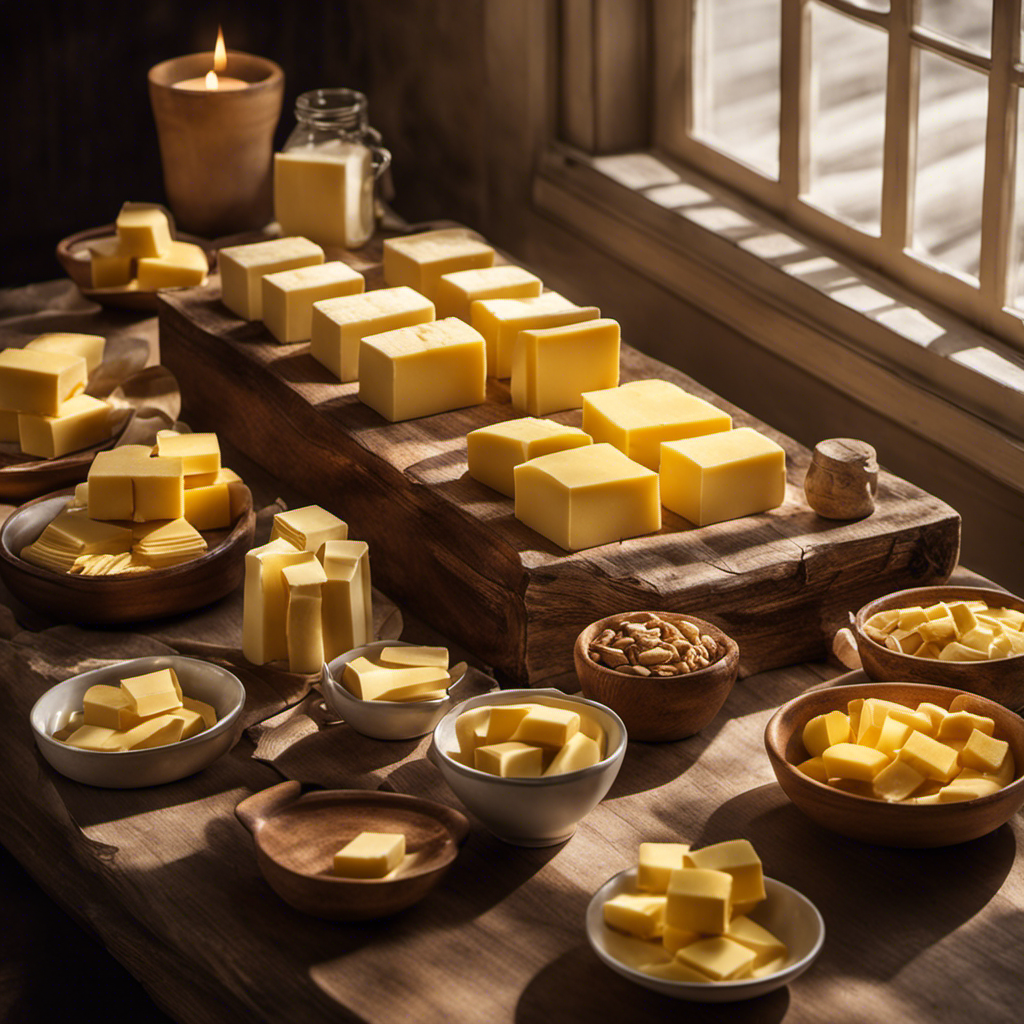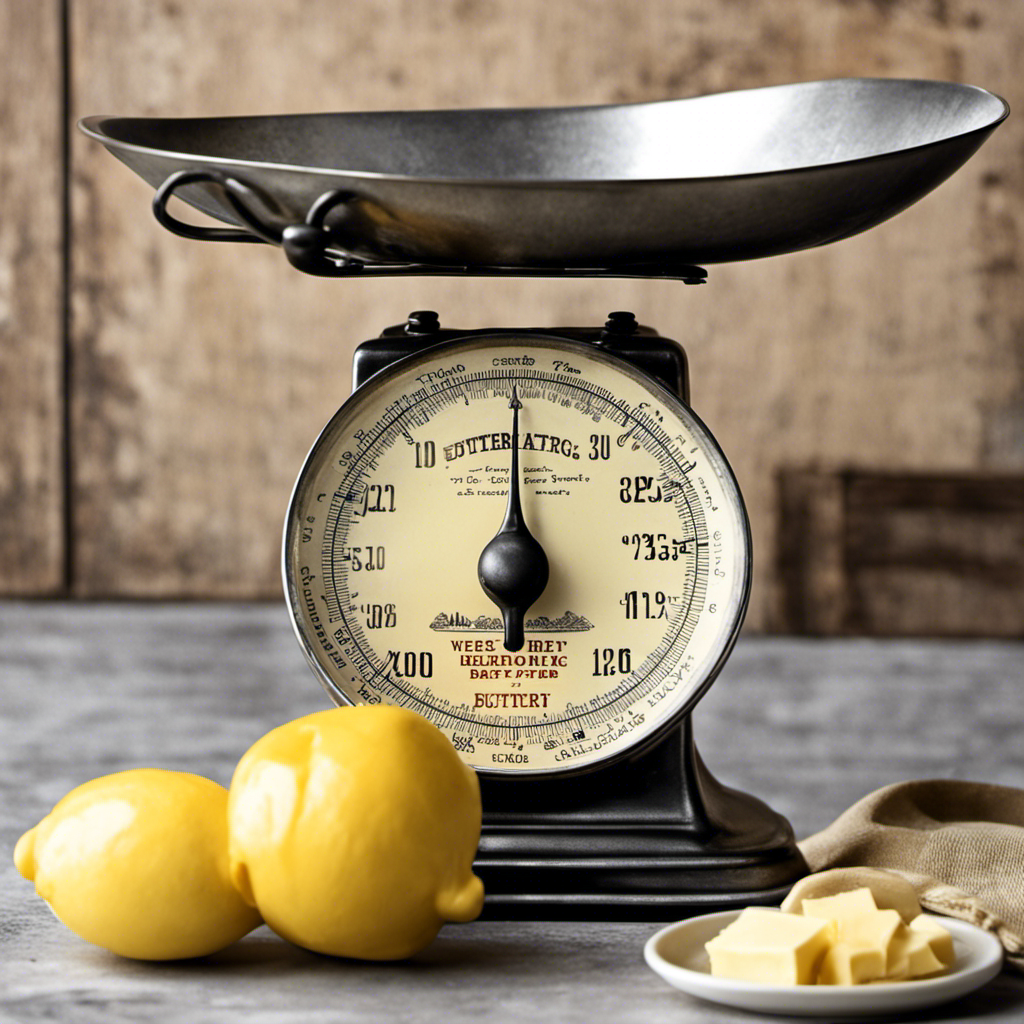As someone who loves ghee butter, I’m always searching for the top spots to snag this liquid gold.
Picture yourself strolling through the aisles of your local grocery store or health food store, eyes scanning the shelves for that unmistakable jar of pure, creamy ghee.
Or perhaps you prefer the convenience of online shopping, clicking and adding to cart the finest ghee from reputable retailers.
But let’s not forget the hidden gems – farmers markets, ethnic and specialty food stores – where you might uncover unique and homemade ghee options.
Join me on a journey to discover the ultimate sources for buying ghee butter.
Key Takeaways
- Local stores such as grocery stores and convenience stores offer easily accessible options for purchasing ghee butter, including traditional and flavored varieties.
- Health food stores like local co-ops, natural food markets, and organic grocery stores are the best sources for finding high-quality ghee butter.
- Online retailers like Organic Valley and Ancient Organics provide convenient and reliable access to a variety of ghee butter brands, offering numerous health benefits.
- Farmers markets offer locally made ghee butter, free from additives and preservatives, allowing customers to support local farmers and learn about the ghee butter-making process.
Local Grocery Stores
You can find ghee butter at the local grocery stores nearby. These local supermarkets are a great place to find a wide variety of ghee butter brands and flavors.
When you walk down the aisles, you’ll see shelves lined with jars of golden ghee, tempting you with its rich aroma. The convenience stores in the area also stock ghee butter, making it easily accessible for those who prefer to shop closer to home.
The local grocery stores and convenience stores understand the demand for ghee butter and ensure that they have enough stock to meet the needs of their customers. Whether you’re looking for traditional ghee or flavored options like garlic or truffle, you can trust that the local grocery stores and convenience stores will have you covered.
Health Food Stores
When it comes to finding health food stores, check out places that specialize in organic products. These stores are often the best sources for finding high-quality ghee butter.
Here are four types of health food stores to consider:
-
Local co-ops: These community-owned stores focus on providing organic and locally sourced products, including ghee butter.
-
Natural food markets: These stores specialize in natural and organic products, offering a wide range of options, including ghee butter.
-
Organic grocery stores: These stores exclusively sell organic products, ensuring that the ghee butter they carry meets strict organic standards.
-
Health food retailers: These stores cater to customers looking for healthy and natural alternatives, making them a great place to find ghee butter.
Online Retailers
If you’re looking for organic and natural alternatives, online retailers are a great option to consider. When it comes to ghee butter, there are several brands available that offer high-quality products.
One popular brand is Organic Valley, known for their commitment to organic farming practices. They produce ghee butter from grass-fed cows, ensuring a rich and flavorful product.
Another brand to consider is Ancient Organics, which specializes in traditional Ayurvedic ghee made from pure butter. These brands, along with others, can be easily found and purchased online.
In addition to its delicious taste, ghee butter also offers numerous health benefits. It is rich in vitamins A, D, E, and K, as well as healthy fats and antioxidants. It is also lactose-free and can be a good option for those with dairy sensitivities.
Overall, online retailers provide a convenient and reliable way to access a variety of ghee butter brands and enjoy their health benefits.
Farmers Markets
Contrary to popular belief, farmers markets are not just for fresh produce and artisanal products. They are also a great place to find high-quality ghee butter. Here are some reasons why buying ghee butter from farmers markets is beneficial:
-
Freshness: Farmers markets offer ghee butter that is made locally and often on the same day. This ensures that you are getting the freshest product possible.
-
Authenticity: Ghee butter available at farmers markets is often made using traditional methods, free from additives and preservatives. It is the real deal.
-
Support local farmers: By purchasing ghee butter from farmers markets, you are directly supporting local farmers and their livelihoods.
-
Personalized experience: At farmers markets, you can talk to the farmers themselves, ask questions, and learn more about the ghee butter-making process.
When selecting the best quality ghee butter at farmers markets, keep these tips in mind:
-
Look for a golden yellow color and a rich, nutty aroma.
-
Check the ingredients list to ensure that it is made from high-quality, grass-fed butter.
-
Consider the packaging. Opt for glass jars or metal tins that protect the ghee butter from light and air.
-
Trust your taste buds. Sample different varieties and choose the one that suits your preferences.
Ethnic Food Stores
When it comes to finding ethnic food stores that offer ghee butter, there are several factors to consider.
First, it’s important to explore the local availability options in your area, as some neighborhoods may have a variety of stores that cater to different ethnic cuisines.
Additionally, online purchasing alternatives can provide a convenient way to access a wider range of options, especially if you’re looking for specific brands or flavors.
Lastly, price comparison suggestions can be helpful in ensuring that you’re getting the best deal possible, as prices can vary greatly between different stores and online platforms.
Local Availability Options
You can easily find ghee butter at your local grocery store or health food store. Here are four additional places where you might be able to find this delicious and versatile ingredient:
-
Local Farmers Markets: Many farmers markets offer a wide variety of organic food options, including ghee butter. Check out your local market and support local farmers while getting your ghee fix.
-
Organic Food Stores: Specialty stores that focus on organic and natural products are likely to carry ghee butter. These stores often have a wider selection of organic food options, making it easy to find the ghee butter you’re looking for.
-
Online Retailers: If you can’t find ghee butter locally, don’t worry! Many online retailers offer a range of ghee butter brands, allowing you to conveniently order it from the comfort of your own home.
-
Ethnic Food Stores: Some ethnic food stores, particularly those that specialize in Indian or Middle Eastern cuisine, may stock ghee butter. These stores are often a treasure trove of unique and hard-to-find ingredients.
With these options, you shouldn’t have any trouble finding ghee butter to enhance your cooking and enjoy its rich, nutty flavor.
Online Purchasing Alternatives
If local availability is limited, there are online retailers where ghee butter can be conveniently purchased. These online platforms offer a wide variety of ghee butter brands and flavors, making it easy to find the perfect option for your needs.
One advantage of purchasing ghee butter online is the option for local delivery. Many online retailers partner with local delivery services to bring your favorite ghee butter right to your doorstep. This eliminates the need to go out and search for it in stores.
Additionally, some online retailers offer subscription services, allowing you to receive regular deliveries of ghee butter without the hassle of reordering. This is particularly beneficial for those who use ghee butter frequently and want to ensure a constant supply.
With online purchasing alternatives, buying ghee butter has never been easier.
Price Comparison Suggestions
To compare prices, take advantage of features on online platforms like price filters and customer reviews. These tools can help you make informed decisions and find the best deal for your budget.
When comparing prices for ghee butter, consider the following factors:
-
Quality vs. price considerations: Look for brands that offer a good balance between quality and affordability. Pay attention to customer reviews to ensure the product meets your expectations.
-
Organic vs. conventional options: Decide whether you prefer organic or conventional ghee butter. Organic options may be more expensive, but they are produced without the use of synthetic pesticides or fertilizers.
-
Quantity: Check the quantity of ghee butter you are getting for the price. Some brands may offer larger or smaller sizes, so make sure you are comparing prices based on the same quantity.
-
Shipping costs: Take into account any additional costs such as shipping fees when comparing prices. Sometimes, a slightly higher price with free shipping may end up being more cost-effective than a lower price with added shipping charges.
Specialty Food Stores
When it comes to finding specialty foods, there are two main options to consider: online availability and local grocery stores.
Online availability options offer a wide range of specialty foods that may not be easily found in local stores, allowing for convenience and accessibility.
On the other hand, local grocery stores can provide a more personalized experience, where you can see and touch the products before making a purchase.
Both options have their advantages and it ultimately depends on individual preferences and needs.
Online Availability Options
You can easily find ghee butter online from various retailers. Here are some options to consider:
-
Amazon: This popular online marketplace offers a wide selection of ghee butter brands, including organic and grass-fed options.
-
Thrive Market: This online retailer specializes in healthy and organic products, making it a great place to find high-quality ghee butter.
-
iHerb: Known for its extensive range of natural and organic products, iHerb offers a variety of ghee butter options to suit different dietary needs.
-
Etsy: If you’re looking for artisanal or homemade ghee butter, Etsy is a great platform to explore. You can find unique flavors and support small businesses.
Ghee butter has numerous health benefits, such as being rich in vitamins A, D, E, and K, as well as being lactose-free. If you prefer making ghee butter at home, it’s a simple process that involves clarifying butter to remove milk solids.
Local Grocery Stores
Local grocery stores often carry a variety of options for purchasing ghee butter. When it comes to ghee, I prefer to support local farmers and ensure quality assurance for the products I buy.
There are several benefits of buying locally sourced ghee, including knowing where your food comes from and supporting the local economy. By purchasing ghee from local farmers, you can have peace of mind knowing that the product is made with care and attention to detail. Additionally, you are helping to sustain local agricultural practices and supporting farmers in your community. It’s a win-win situation!
Now, let’s explore another option for obtaining ghee: making it at home.
Homemade Ghee Options
If you’re looking for homemade ghee options, there are several recipes available online that you can try. Making ghee at home is a simple and rewarding process that allows you to customize the flavor to your liking.
Here are some recipe ideas to get you started:
-
Traditional Ghee: This recipe involves slowly simmering unsalted butter until the milk solids separate and the liquid turns golden. The result is a rich and nutty ghee that is perfect for cooking and baking.
-
Clarified Butter Ghee: This method involves melting butter and skimming off the foam, leaving behind pure golden ghee. It’s a quick and easy way to make ghee without the need for straining.
-
Flavored Ghee: Experiment with adding spices like cinnamon, cardamom, or turmeric to infuse your ghee with unique flavors and health benefits.
-
Vegan Ghee: For those following a plant-based diet, try making ghee using coconut oil or vegan butter substitutes.
Homemade ghee not only adds a delicious flavor to your dishes but also provides numerous health benefits. It is rich in healthy fats, vitamins, and antioxidants, and has been linked to improved digestion, reduced inflammation, and enhanced brain function.
Frequently Asked Questions
What Are the Health Benefits of Consuming Ghee Butter?
Ghee butter has several health benefits. It can aid in weight loss by boosting metabolism and reducing appetite. Additionally, it promotes heart health by increasing good cholesterol levels and reducing the risk of heart disease.
Is Ghee Butter Suitable for Individuals With Lactose Intolerance or Dairy Allergies?
Ghee butter is suitable for individuals with lactose intolerance or dairy allergies. It contains negligible amounts of lactose and casein, making it easier to digest. It’s a great alternative for those with dietary restrictions.
Can Ghee Butter Be Used as a Substitute for Regular Butter in Cooking and Baking?
Ghee butter can be a suitable substitute for regular butter in cooking and baking. It has a rich, nutty flavor and a creamy texture. Additionally, ghee butter is considered a healthier alternative due to its higher smoke point and lower lactose content.
How Long Does Ghee Butter Typically Last Before It Goes Bad?
Ghee butter typically lasts for a long time before it goes bad. Its shelf life can be extended by proper storage, such as keeping it in an airtight container in a cool, dark place.
Are There Any Specific Brands or Types of Ghee Butter That Are Recommended for Specific Dietary Preferences, Such as Organic or Grass-Fed Options?
There are several ghee butter brands that are recommended for a keto diet, such as Fourth & Heart and Ancient Organics. If you’re looking for affordable organic ghee butter, you can find it at local health food stores or online retailers.
Conclusion
In conclusion, after exploring various options, I have discovered that ghee butter can be easily obtained from numerous sources.
Local grocery stores, health food stores, online retailers, farmers markets, ethnic food stores, and specialty food stores all offer a wide selection of ghee butter.
Additionally, for those who prefer a homemade option, there are various recipes available.
So, whether you’re looking for convenience or a unique homemade touch, finding ghee butter is as easy as pie.









